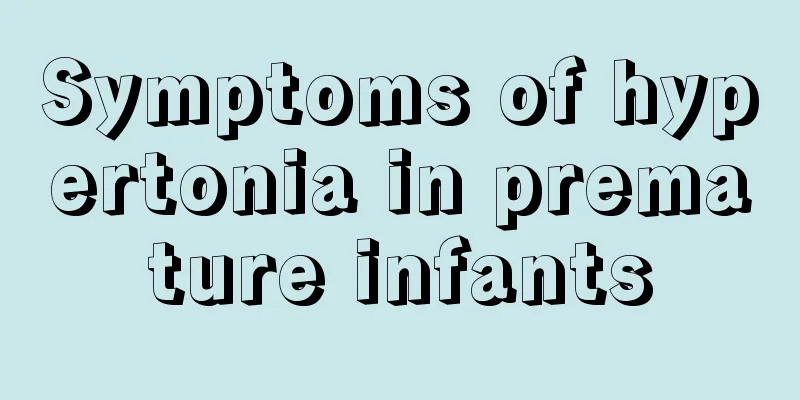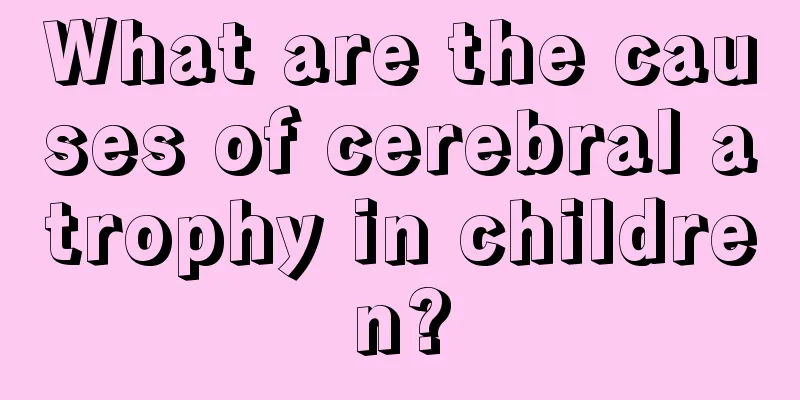Symptoms of hypertonia in premature infants

|
High muscle tone is a common symptom in newborns, especially in premature infants with malnutrition, the incidence rate is relatively high. When children have symptoms such as high muscle tone, they generally have tight muscles, reduced limb movements, and inability to keep the soles of their feet flat. If the high muscle tone of premature infants is not diagnosed and treated in time, it will have a great impact on the child's growth and development. 1. Symptoms of high muscle tone in premature infants High muscle tone in infants needs to be detected and treated in time, but it can easily be confused with other diseases, so you need to understand its symptoms first. Muscle tone refers to the tension of muscles when they are at rest and relaxed. Muscle tone is the basis for maintaining various body postures and normal movements, and manifests itself in various forms. There are: positive Babinski reflex, positive jackknife reflex, positive clonus, positive decerebrate rigidity and positive decorticate rigidity. The main clinical features of high muscle tone are more common in children and newborns. The main clinical symptoms are tight muscles, significantly reduced limb movement, and stereotyped and awkward movements. The head is often not in the middle position, but often turned to one side or leaning back, and the hands and shoulders are rotated inward and downward, flexed or extended. The hands are often in a fist shape, with the thumb against the palm and the other four fingers holding the thumb, with the back of the hand facing forward and the palm facing down. The spine often has varying degrees of kyphosis or scoliosis, and the hip joints often cannot fully extend and maintain a certain degree of flexion. The lower limbs are often crossed, and the Achilles tendon is tense, which makes it impossible to keep the sole of the foot flat when standing, and the feet can only touch the ground on tiptoe. If the child encounters a similar situation as mentioned above, he should go to a professional hospital for timely medical treatment. Treatment of high muscle tension Once high muscle tone in an infant affects the infant's health, scientific methods should be chosen for treatment. 1. Physical therapy: suitable for younger patients. The recurrence rate is high, the safety factor is not high, and it is easy to cause new deformities. Traditional treatments, whether surgery, medication, rehabilitation training, etc., are relatively single-minded and only repair one of the lesions, resulting in many patients not being cured for a long time. Since conventional treatments for hypertonia are relatively limited, hypertonia has become a difficult disease to treat. 2. With the continuous development of medical technology, the difficulty in treating hypertonia has been overcome, laying the foundation for the treatment of hypertonia-type cerebral palsy, and becoming a major breakthrough in the medical treatment of cerebral palsy. After receiving clinical treatment, the patient's symptoms of high muscle tension will generally be significantly improved after one week, the discomfort symptoms will disappear, and the disease will be basically cured in half a month. Even for patients with complicated and critical cerebral palsy, extending the clinical treatment cycle can still allow them to recover and take care of themselves. Judging from clinical diagnosis and rehabilitation data, this technology has an efficiency of up to 96.8%, making it the most effective technology for treating cerebral palsy. 3. The harm of high muscle tension in infants The disease of high muscle tone in infants is not common, but once it occurs, it can cause great harm to the child's physical and mental health. If a baby has high muscle tone, it may lead to uneven muscle growth at the mildest level or abnormal walking posture at the worst level, such as turning one's feet inward or walking with one's butt sticking out. Therefore, abnormal muscle tone should be detected, intervened and treated early. Usually, the baby's physical examination should be able to detect the disease at 3 months old, and treatment within 4 months is considered early intervention. Generally, the treatment is effective, the improvement is rapid, and it can be completely cured without affecting the future motor development. Corrective treatment should be given before the age of one and a half at the latest. |
<<: How do you know if your baby is cold or hot?
>>: What to do if premature babies have high jaundice
Recommend
What should I do if my child has abdominal distension and diarrhea?
When children show symptoms of abdominal distensi...
Is it normal for children to poop three times a day?
In general, the number of times people defecate i...
Causes and treatments of armpit ulcers in babies
Armpit ulcers in babies look very scary. Recently...
Why does a one-month-old baby have mucus in his nose?
Human beings are strange yet advanced animals. Bi...
What should I do if my child has low white blood cell count and high fever?
Spring is the peak season for influenza, and cold...
High lead level in baby
Family members cannot tell with the naked eye whe...
What to do if your child has a foreign body sensation in his eyes
The child's body is developing and growing. I...
Taboos of drinking goat milk powder
In life, many mothers do not have enough breast m...
Is it normal for a newborn to poop as soon as he feeds?
Many newborns have a problem, that is, if they ar...
Which type of teething stick is better for children?
When children reach the stage of growing teeth, t...
Why does the child not sleep and keeps crying?
It is an abnormal situation for children to not s...
What is the cause of the baby's high fever and diarrhea?
Baby fever and diarrhea are relatively common dis...
What are the symptoms of baby's bloating?
It is very common for babies to have a bloated be...
What to do if your child has enuresis
Nowadays, many children suffer from enuresis due ...
What is the standard for childhood obesity?
In modern society, there are more and more obese ...









